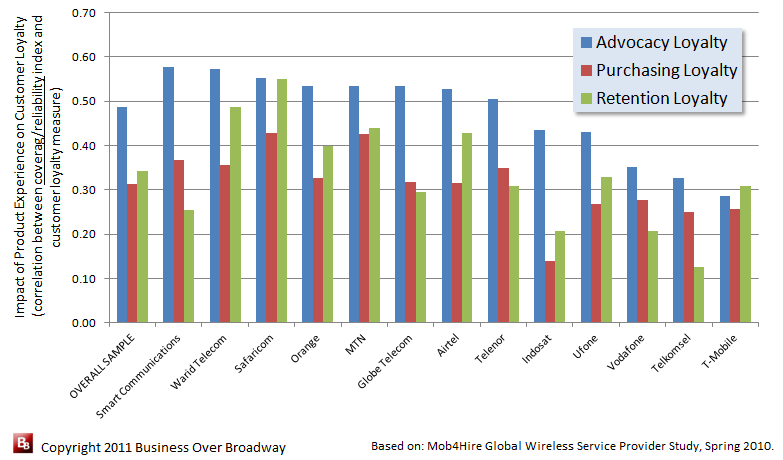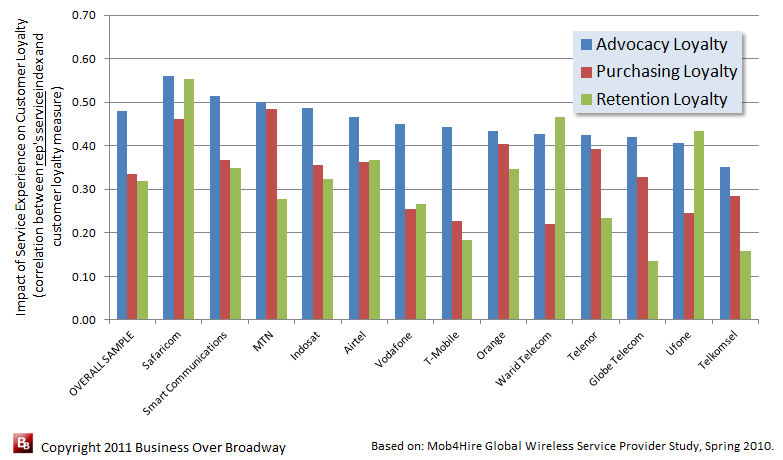Customers can exhibit many different types of loyalty behaviors toward a company (e.g., recommend, purchase same, purchase different products, stay/leave), each responsible for different types of business growth. Furthermore, when asked about their loyalty behaviors via relationship surveys, customers’ ratings of loyalty questions show that customer loyalty essentially boils down to three different types of customer loyalty:
- Retention Loyalty: Degree to which customers will remain as customers or not leave to competitors. This type of loyalty impacts overall customer growth.
- Advocacy Loyalty: Degree to which customers feel positively toward/will advocate your product/service/brand. This type of loyalty impacts new customer growth.
- Purchasing Loyalty: Degree to which customers will increase their purchasing behavior. This type of loyalty impacts average revenue per customer.
These three distinct types of customer loyalty form the foundation of the RAPID loyalty approach. Using the RAPID loyalty’s multi-faceted approach helps companies understand how improving the customer experience can improve business growth in different ways. If interested, you can read my recent article on the development of the RAPID loyalty approach.
Product and Service Experience
Customer experience management (CEM) is the process of understanding and managing customers’ interactions with and perceptions about your company/brand. The ultimate goal of this process is to improve the customer experience and, consequently, increase customer loyalty. Two primary customer experience areas that are commonly assessed are the customers’ perception of their 1) product experience and 2) service experience. These two areas are shown to be among the top drivers of customer loyalty; customers who have a good experience in these two areas report higher levels of customer loyalty than customers who have a poor experience.
How does Product and Service Experience Impact Each Type of Customer Loyalty?
To understand the impact of the product and service experience on different facets of customer loyalty, I used existing survey data. Last year, Mob4Hire, a global crowd-sourced testing and market research community, and I conducted a worldwide survey, asking respondents’ about their experience with and loyalty towards their current wireless service provider. To measure the product and service experiences, respondents were asked to indicate their agreement about statements that describes their provider (1 to 5 – higher scores indicate agreement and better customer experience). As a measure of the product experience, we averaged respondent’s ratings across two questions: 1) good coverage in my area and 2) reliable service (few dropped calls). As a measure of the service experience, we averaged respondent’s ratings about their provider’s representatives across 5 areas: 1) responds to needs, 2) has knowledge to answer questions, 3) was courteous, 4) understands my needs and 5) always there when I need them. The survey also asked about the respondents’ loyalty toward their wireless service provider across the three types of loyalty: 1) retention, 2) advocacy and 3) purchasing.
To index the degree of impact that each customer experience dimension has on customer loyalty, I simply correlated the ratings of each customer experience dimension (Coverage/Reliability; Customer Service) with each of the three loyalty measures (Retention, Advocacy, Purchasing). I did this analysis for the entire dataset and then for each of the wireless service providers who had more than 100 respondents. Figure 1 contains the results for the impact of Coverage/Reliability on customer loyalty.

Figure 1. Impact of Product Experience on Retention, Advocacy and Purchasing Loyalty. Click image to enlarge.
As you can see in Figure 1, using the entire sample (far left bars), the product experience has the largest impact on advocacy loyalty (r = .49), followed by purchasing (r = .31) and retention loyalty (r = .34). Similarly, in Figure 2, using the entire sample (far left bars), the service experience has the largest impact on advocacy loyalty (r = .48), followed by purchasing (r = .34) and retention loyalty (r = .32). Generally speaking, while improving the product and service experience will have the greatest impact on advocacy loyalty, improvement in these areas will have an impact, albeit a smaller one, on purchasing and retention loyalty. I find this pattern of results in other industries as well.
Looking at individual wireless service providers in Figures 1 and 2, however, we see exceptions to this rule (Providers were ordered by their Advocacy Loyalty scores.). For example, we see that improving the product experience will have a comparable impact on different types of loyalty for specific companies (Figure 1 – T-Mobile, Safaricom). Additionally, we see that improving the service experience will have a comparable impact on different types of loyalty for specific companies (Figure 2 – Safaricom, MTN, Orange, Warid Telecom, Telenor, and Ufone). The value of improving the service experience is different across companies depending on the types of customer loyalty it impacts. For example, improving the service experience is much more valuable for Safaricom than it is for T-Mobile. Improving the service experience will greatly impact all three types of customer loyalty for Safaricom and only one for T-Mobile. I suspect the reasons for variability across providers in what drives their customer loyalty could be due to company maturity, the experience delivery process, market pressures and customer type. Deeper analyses (e.g., stepwise regression, path analysis) of these data for specific providers could help shed light on the reasons.

Figure 2. Impact of Service Experience on Retention, Advocacy and Purchasing Loyalty. Click image to enlarge.
Benefits of Measuring Different Types of Customer Loyalty
Improving the customer experience impacts different types of customer loyalty and this pattern varies across specific companies. For some companies, improving the customer experience will primarily drive new customer growth (advocacy loyalty). For other companies, improving the customer experience will also significantly drive existing customer growth (retention and purchasing loyalty).
Companies who measure and understand different types of customer loyalty and how they are impacted by the customer experience have an advantage over companies who measure only one type of loyalty (typically advocacy):
- Companies can target solutions to optimize different types of customer loyalty to improve business growth. For example, including retention loyalty questions (e.g., “likelihood to quit”) and a purchasing loyalty questions (e.g., “likelihood to buy different”) can help companies understand why customers are leaving and identify ways to increase customers’ purchasing behavior, respectively.
- Key performance indicators (KPIs) can be identified for each type of customer loyalty. Identification of different KPIs (key drivers of customer loyalty) helps companies ensure they are monitoring all important customer experience areas. Identifying and monitoring all KPIs helps ensure the entire company is focused on matters that are important to the customer and his/her loyalty.
- Companies are better equipped to quantify the value of their CEM program and obtain more accurate estimates of the Return on Investment (ROI) of the program. The ROI of a specific improvement opportunity will depend on how the company measures customer loyalty. If only advocacy loyalty is measured, the estimate of ROI is based on new customer growth. When companies measure advocacy, purchasing and retention loyalty, the estimate of ROI is based on new and existing customer growth.
Final Thoughts
The primary goal of CEM is to improve customer loyalty. Companies that narrowly define customer loyalty are missing out on opportunities to fully understand the impact that their CEM program has on the company’s bottom line. Companies need to ensure they are comprehensively measuring all facets of customer loyalty. A poor customer loyalty measurement approach can lead to sub-optimal business decisions, missed opportunities for business growth and an incomplete picture of the health of the customer relationship.



 Beyond the Ultimate Question
Beyond the Ultimate Question Measuring Customer Satisfaction and Loyalty (3rd Ed.)
Measuring Customer Satisfaction and Loyalty (3rd Ed.)
[…] between satisfaction with the customer experience and NPS to be around .70. Similarly, in my research, I have found comparably sized correlations (r ≈ .50) looking at the impact of the customer […]
[…] guide product development, and improve service quality, just to name a few. The end goal is to create a loyal customer base (e.g., customers come back, recommend and expand […]
[…] guide product development, and improve service quality, just to name a few. The end goal is to create a loyal customer base (e.g., customers come back, recommend and expand […]